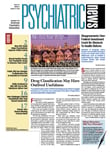Medicaid is expected to fund an increasing share of mental health treatment costs though 2014, while state and local governments will take on more responsibility for substance abuse treatment spending.
Further, prescription medications will likely account for 30 percent of all mental health spending by 2014.
Those were some conclusions by the Substance Abuse and Mental Health Services Administration from a projection of mental health and substance abuse spending, based on historical spending estimates. The projections appear in the November/December 2008 Health Affairs.
Spending on mental health, including substance abuse treatment, is expected to double between 2003 and 2014, to $239 billion, and is anticipated to continue falling as a share of all health spending.
By 2014, projections of substance abuse spending show increasing responsibility for state and local governments (45 percent), deteriorating shares financed by private insurance (7 percent), and 42 percent of substance abuse spending going to specialty substance abuse centers.
Regarding mental health care, Medicaid is forecasted to fund an increasingly larger share of treatment costs (27 percent).
The projections also looked at where the dollars would be going. The share of all mental health spending on care by physicians is forecasted to rise from 14 percent in 2003 to 16 percent in 2014.
Psychiatrists alone accounted for about 70 percent of mental health physician spending in 2003 and are expected to account for this amount in 2014. Other providers of mental health care are nonpsychiatric physicians, including primary care physicians, according to the report.
But the report noted that spending on treatment by primary care physicians may be underestimated because prescriptions for psychotropic medications are often written by these nonspecialty physicians without specifically listing an accompanying principal mental health diagnosis used to identify mental health spending.
“But the big story of the last 10 or 15 years and into the future is the increasing dominance of Medicaid in the financing of mental health treatment costs,” study coauthor Jeffrey Buck, Ph.D., told Psychiatric News. “That is the overwhelming direction in terms of national policy.”
He is chief of the Survey, Financing, and Analysis Branch of the federal Centers for Mental Health Services.
Buck said the trend is a challenge for providers of public mental health care used to working in an environment in which services are funded by grants from the state.
“There is a higher level of accountability [in Medicaid],” Buck said. “You have to generate claims data and demonstrate that the services were delivered to people who were eligible. You have to document all of that, and it has to be auditable.”
Projections Don't Account for Reform
To project mental health and substance abuse spending, Buck and colleagues used a five-factor growth model, allocating historical spending growth to these five factors: changes in population, service use per person, general inflation, service-specific net price increases, and a “residual” measuring intensity of service use. Projections of growth in population and general inflation were taken from the Old-Age, Survivors, and Disability Insurance Trustees Report.
Projections of increases in all other factors were developed as extensions of historical trends. This research was done by the health care division of Thompson Reuters of Washington, D.C.
Buck and authors acknowledged that the projections are rough estimates that do not take into account changes in the political and economic climate, such as the likelihood of major health system reform in coming years. The report was also prepared prior to passage of the mental health parity act.
Also unknown, wrote the authors, is the effect of the transition to a prospective-payment system for psychiatric hospital stays; that change is likely to alter incentives for clinicians. But they predicted slightly slower growth for treatment of mental illness in general hospitals (averaging 6.2 percent annually) and even slower growth for specialty hospitals (averaging 2.1 percent annually).
“On the provider side, the biggest changes are the rise in spending on psychotropic drugs and the relative decline in spending on inpatient care,” Buck told Psychiatric News. “If you look at dollars for inpatient care, it is the share spent on specialty hospitals that is really shrinking.”
Growth in Medicaid Expected
Howard Goldman, M.D., editor of the APA journal Psychiatric Services, said the growth in importance of Medicaid comes as no surprise.“ Even without health insurance reform, Medicaid is likely to continue to grow as the economy worsens and more people are on Supplemental Security Income and TANF [Temporary Assistance for Needy Families], and Medicare will grow as the population ages and chooses [to file for Social Security Disability Insurance (SSDI)] rather than work in an ailing economy.”
(Traditionally there are more applications for SSDI during hard economic times.)
Goldman added, however, that spending projections are likely to be altered significantly by health system reform efforts—a factor not accounted for in these “current law” projections.
“I expect that health care reform activities in the new administration will alter the distribution of pay sources for mental health expenditures as the ranks of the uninsured population decline and new coverage becomes available,” he said. “People with mental disorders are overrepresented among those without insurance, so there could be shifts in the distribution of expenditures with expansions of coverage.”
He also said the new Paul Wellstone and Pete Domenici Mental Health Parity and Addiction Equity Act of 2008 would have some effect “Parity should shift some mental health care expenditures from public sources to private sources as people have better private insurance coverage for treating mental disorders,” Goldman said.
He said the most important impact of the parity law will be the decrease in out-of-pocket spending by patients receiving services.
